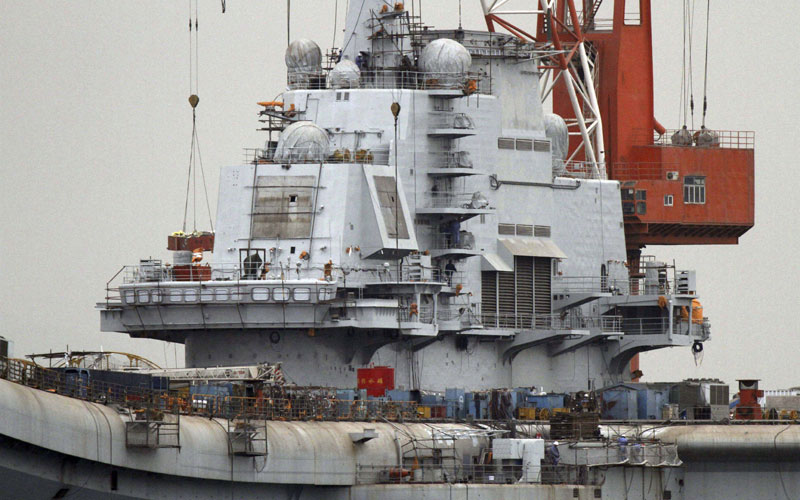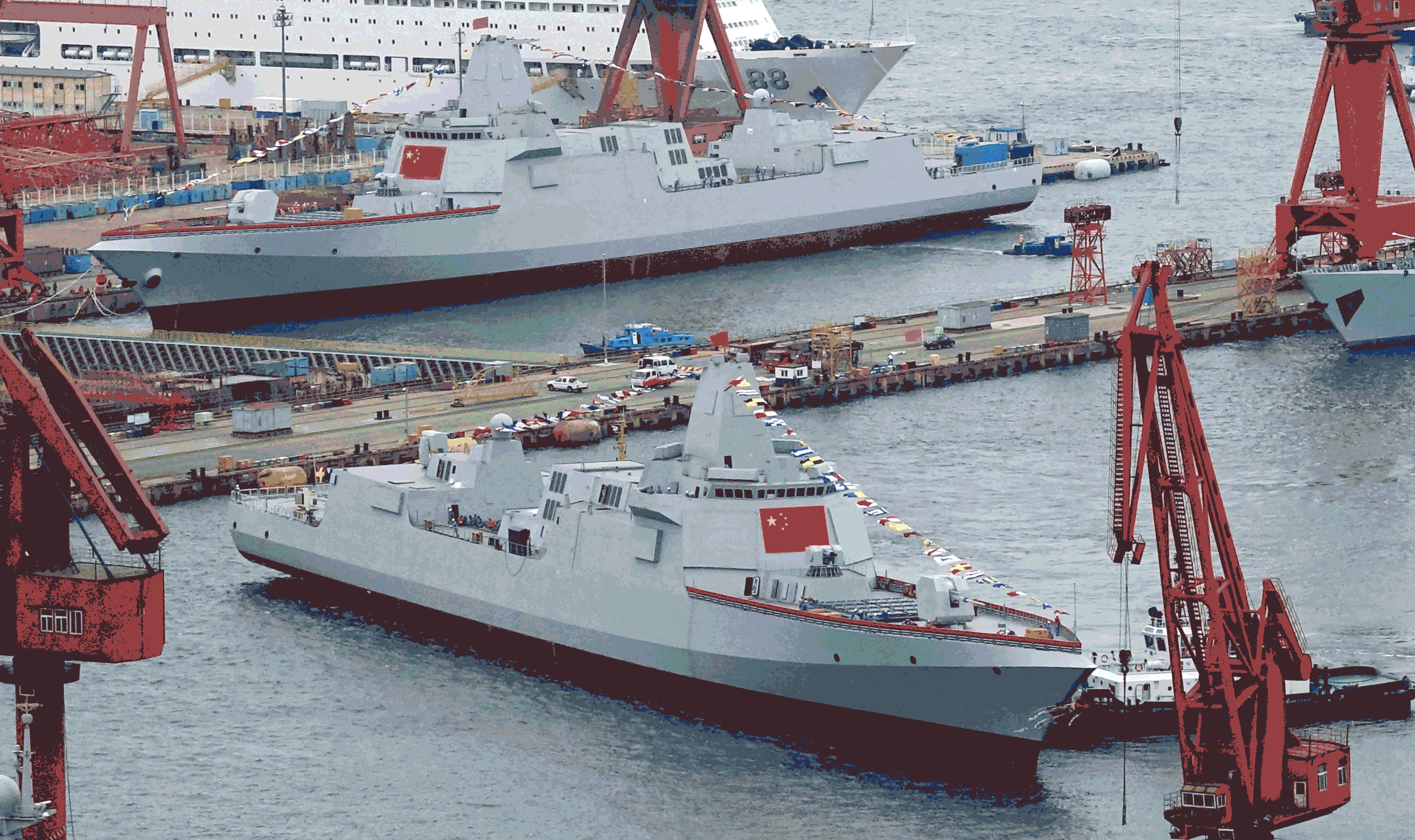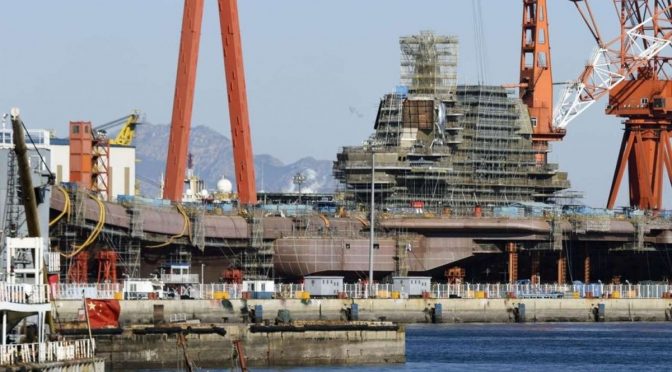By Andrew S. Erickson
In recent years, China has been building ships rapidly across the waterfront. Chinese sources liken this to “dumping dumplings into soup broth.” Now, Beijing is really getting its ships together in both quantity and quality. The world’s largest commercial shipbuilder, it also constructs increasingly sophisticated models of all types of naval ships and weapons systems. What made this possible, and what does it mean?
History and Drivers
China’s shipbuilding industry enjoyed early and inherent advantages that its aircraft industry, for example, notably lacked. Unlike most other sectors, its infrastructure could not be physically relocated far inland as part of Mao’s disastrously inefficient Third Front campaign. When Deng began reforms at the end of the 1970s, he prioritized shipbuilding to support the shipping industry, which helped carry foreign trade, underwriting several decades of rapid growth that has changed China, the United States, and the world significantly.
In 1982, China State Shipbuilding Corporation was formed from the Sixth Ministry of Machine Building. That same year, the Middle Kingdom made its first delivery to the international ship market. Abundant cheap labor and domestic demand buoyed Chinese shipwrights despite a ruthlessly competitive international market.
Shipbuilding’s commercial dual-use nature has long facilitated transfer and absorption of much foreign technology, standards, and design and production techniques. China’s shipbuilding industry has leapfrogged key steps, focusing less on research and more on development, thereby saving time and resources and enjoying the most rapid growth in modern history.
China’s current naval buildout dates to the mid-1990s, catalyzed and accelerated in part by a series of events that impressed its leaders with their inability to counter American military dominance. These include Operation Desert Storm in 1991, the Third Taiwan Strait Crisis in 1995-96, and the Belgrade Embassy Bombing in 1999.
Fleet Modernization
Ships are the physical embodiment of naval strategy—the most essential element through which a nation pursues its goals at sea. China has parlayed the world’s second-largest economy and second-largest defense budget into the world’s largest ongoing comprehensive naval buildup, which has already yielded the world’s largest navy by number of ships. It is making big waves, ever-farther from its shores.
After shrinking to replace many obsolescent vessels with fewer but more modern vessels in the 1990s and 2000s, the People’s Liberation Army Navy (PLAN) is now improving in both numbers and sophistication. As China’s maritime strategy has evolved, so have PLAN requirements. In response to this major growth in perceived needs, the PLAN has taken on more warfare areas, with significant improvements across the board. In the 1990s, the PLAN did not have significant strike or air defense capabilities; now it does. To meet high-end, multirole requirements—such as area and point defense in layers—with more missions and greater capabilities, PLAN vessels have grown more sophisticated, and generally expanded. The larger vessels of China’s navy increasingly resemble those of its American counterpart.
Shipbuilding Strengths
Regarding Chinese shipbuilding advantages, it is difficult to obtain specific data. Numbers related to budgeting and process efficiency in China’s relatively opaque defense industry unfortunately remain very difficult to investigate precisely using open sources. The official statistics Beijing releases still do not even include a reliable breakdown for China’s service budgets—such as that of the PLAN—within the overall official PLA budget (itself highly controversial). Because of the lack of precise information available, estimating Chinese ship production expenses logically involves making assumptions about relative costs in comparison to those known for other countries—not an exact science.
Still, the larger dynamics are clear. China has the world’s largest shipbuilding infrastructure, and its development enjoys top-level leadership support, starting with Xi Jinping himself. Commercial production is price-capped in part by China’s relatively stable business and vendor base. It helps subsidize military production, an option closed to the United States given its paucity of commercial shipbuilding. Chinese shipbuilding is greatly facilitated by an unparalleled organizational structure for collecting and disseminating technology, and integrating it into development and production processes at an industrial scale. Moving forward, an important variable is the extent to which China can use its familiar approach of moving up the value chain and parlaying exceptional cost-competitiveness into exceptional quantity at sufficient quality.
China’s effort to exploit civil-military synergies offers both opportunities and challenges. This was vigorously debated by the contributors to the Naval War College China Maritime Studies Institute (CMSI)’s Naval Institute Press volume on Chinese Naval Shipbuilding. “Not a good mix operationally—colocation and coproduction are challenging if not counterproductive” was one of the more pointed critiques. Potential civil-military incompatibilities cited include culture, security, standards, design, engineering, propulsion, construction, and timescales.
Nevertheless, dual-use construction is undeniably emphasized in many authoritative Chinese industry policies and publications, and also in the form of a central commission for integrated military and civilian development headed by none other than Xi himself. There is certainly some intermingling in practice, with the greatest manifestation visible in shipyard infrastructure. High-tech, high-value-added, and high reliability commercial shipbuilding—for example, of liquid natural gas (LNG) and liquid propane gas (LPG) tankers, very large crude carriers (VLCCs), high-capacity container ships carrying more than 10,000 twenty-foot equivalent units (TEU), and even cruise ships—can be directly relevant to warship production in a way that building simple ships like bulk carriers is not.
Beijing’s prioritized military sector generally enjoys better funding, infrastructure, and human capital in the form of advanced personnel—such as engineers with long-term experience, as opposed to rapid turnover. The proof is in the pudding: the PLAN is “not receiving junk” from China’s shipbuilding industry but rather increasingly sophisticated, capable vessels. Its growing satisfaction with them is indicated in part by longer production runs of fewer classes.
A more specific question remains: what limitations on high-end capabilities plague Chinese-produced warships? For now, China faces substantial difficulties in fielding the largest, most sophisticated surface combatants and submarines, as well as remaining weaknesses in propulsion and electronics. These all involve complex systems-of-systems in which China’s preferred second-mover piecemeal integration of foreign and domestic technologies cannot offer a “good enough” result. China’s aircraft carrier program offers a prime example.
Deck Aviation Challenges
With regard to aircraft carrier development, China has come a long way but has still has further to go. The appeal is clear: these apex predators of the sea are also the most modularized naval system, one of the few ships that are relatively easy to upgrade over a considerable lifespan. But given difficulties inherent in improving marine and aviation propulsion, power, and launch technologies, an evolutionary “crawl, walk, run” trajectory seems likely for China’s aircraft carrier program.
This remains very much a work in progress: the PLAN is still “crawling” and not even “walking” yet. China has already shown that it can build decent carrier hulls. But deck aviation platforms are primarily a conveyance for aircraft-delivered payloads. And there is “no such thing as a free launch.” Payload delivery is essential to a fleet’s performance; so too is having infrastructure sufficient to support and sustain it. China’s first carrier, Liaoning, is designed for air defense, not strike. It offers a very modest extension of air defense: getting a Flanker-type aircraft like the J-15 beyond its unrefueled range from a land-based airfield.
The PLAN faces formidable challenges in such areas as electronics, maritime monitoring, and command; control; communications; computers; intelligence, surveillance and reconnaissance (C4ISR). All are often underappreciated due to their subtlety and ubiquity of employment, but are nonetheless essential for robust deck aviation operations. They may be less amenable to China’s preferred approach of copying and emulation than are simpler structural systems. Chinese personnel are improving markedly in their training, but need to become still more proficient in the hard-to-steal “tribal knowledge” of coordinating operations and using equipment, including shipboard electronics.

With far greater launching power than Liaoning’s ski jump, catapults will enable larger aircraft and payloads, delivering the PLAN to deck aviation’s “walking” stage. Deploying heavier airborne early warning aircraft will improve situational awareness. “Running,” as China perceives it, would require a nuclear-powered aircraft carrier with an electromagnetic launch system—the latter of which the United States is still struggling to perfect.
Carrier Group Assembly
China is gradually strengthening its ability to project significant power into distant waters by increasingly fielding the components of an aircraft carrier group. Sustaining a carrier group at sea requires replenishment vessels. Protecting a carrier group requires surface combatants with robust air defenses and offensive missiles as well as nuclear-powered submarines with potent anti-ship cruise missiles (ASCMs).
To improve at-sea replenishment, China is currently building the Type 901 integrated supply ship, which can furnish fuel, food, and some spare parts. It remains limited in ability to transfer ordnance, its biggest difference from the U.S. Supply class. It is already more than adequate for furnishing air-to-air missiles for Liaoning. It could be refitted with more dry transfer stations to increase ordnance transfer capability—a useful indicator to watch for, which would suggest intent to emulate the United States in long-distance power projection.
As for protection and coordination, the Type 055 cruiser, if it has the command and control facilities described in open sources, will be the centerpiece of future Chinese carrier groups—able to organize other ships somewhat like a U.S. Aegis cruiser does. With 112 vertical launch cells (VLS), this large multi-mission vessel has more than double the missile capacity of any previous PLAN surface combatant. Its VLS loadouts of HHQ-9 surface-to-air missiles suggest great capacity for area air defense, its loadouts of YJ-18 ASCMs offer a significant anti-surface warfare capability, its loadouts of CJ-10 land-attack cruise missiles suggest a nascent potential for projecting power ashore, and its Yu-8 rocket-assisted torpedoes offer an antisubmarine warfare (ASW) capability.

Most navies with aircraft carriers do not protect them with robust submarines, but if China is to approach the American gold standard that it so clearly admires, and to which it apparently aspires, it will have to improve its nuclear-powered submarines, which are needed to allow for a full range of long-distance undersea operations. Even with a towed sonar array, China’s 093A nuclear-powered attack submarine remains at a significant disadvantage in being able to detect, and if necessary, attack enemy submarines while remaining undetected itself. It is still primarily an anti-surface ship platform with torpedo-tube-fireable YJ-18 ASCMs and a relatively noisy reactor, particularly in the secondary loop. Major work remains for China to project distant undersea power.
Near Seas Operational Scenarios
Closer to China’s shores, there is limited value for Chinese carrier operations, given their relative vulnerability and the potential for a highly-contested environment. But China’s shipbuilding industry has already produced a fleet of several hundred increasingly advanced warships capable of “flooding the zone” along the contested East Asian littoral, including increasingly large amphibious vessels well-suited to landing on disputed features, if they can be protected sufficiently. This is also where China’s large, conventionally-powered submarine fleet can be particularly deadly. When several hundred easy-and-cheap-to-build ships from China’s coast guard and its most advanced maritime militia units are factored in, Beijing’s numerical preponderance becomes formidable for the “home game” scenarios it cares about most. And that does not even include the land-based “anti-navy” of aircraft and missiles that backstops them. In this way, Beijing is already able to pose a formidable military-maritime challenge to the regional interests and security of the United States and its East Asian allies and partners.
Trends and Implications
China’s naval buildup is only part of an extraordinary maritime transformation—modern history’s sole example of a land power becoming a hybrid land-sea power and sustaining such an exceptional status. Underwriting this transition are a vast network of ports, shipping lines and financial systems, and—of course—increasingly advanced ships. All told, this raises the rare prospect of a top-tier non-Western sea power in peacetime, one of the few instances to occur since the Ming Dynasty developed cutting-edge nautical technologies and briefly projected unrivaled maritime power across the Indian Ocean. Now, for the first time in six centuries, commercial sea power development has flowed away from the Euro-Atlantic shipyards of the West, back toward an Asian land power that is going seaward to stay. Military sea power may be poised to follow.
Beijing is pursuing a requirements-based approach:
The PLAN’s transition from a “Near Seas” to a “Near and Far Seas” navy is dispersing its fleet over greater distances, making it more difficult to protect and support, as well as requiring enhanced logistics and facilities access.
Some of the most important and challenging requirements include:
- long endurance propulsion—especially nuclear power, the ultimate “gold standard”
- area air defenses for surface combatants and emerging carrier groups
- land-attack and strike warfare, including from deck aviation assets
- ASW
- acoustic quieting for submarines, to help them both survive being targeted in deeper blue-water environments, and search more effectively without limitation by self-generated noise
- and, finally, broad-coverage C4ISR
China has started to pursue all these objectives, but it will take years before it fully accomplishes them.
Already, however, Chinese ship-design and shipbuilding advances are increasing the PLAN’s ability to contest sea control in a widening arc of the Western Pacific. China is producing two to three surface combatants for every one the United States produces. If current trends continue, China will be able to deploy a combat fleet that in overall order of battle (meaning, hardware-specific terms) is quantitatively larger and qualitatively on par with that of the U.S. Navy by 2030.
Whether China can stay on this trajectory, given looming maintenance costs and downside risks to its economy as it faces an S-curved growth slowdown, is another question. It is a question that is linked to many other uncertainties about China’s future. China under Xi is becoming increasingly statist and militarized, thereby suggesting that naval shipbuilding will not suffer for lack of resources even as debt continues to spiral upward in state-owned enterprises. China’s very capable shipbuilding industry is closing remaining gaps with its Japanese and Korean rivals, even as Korean shipbuilders suffer unprofitability and rapidly-declining order books. However, China faces continued challenges in overcapacity and an aging workforce.
Moreover, a major mid-life maintenance bill for the overhauls of all new PLAN vessels will start coming due in the next 5-10 years. This will demand considerable resources—in money and shipyard space, with production and maintenance in potential competition. By then, China’s aging society may reorient resource allocation by stimulating “guns vs. butter,” and even “guns vs. canes” debates. The true long-term cost of sustaining top-tier sea power tends to eventually outpace economic growth by a substantial margin. For all its rapid rise at sea thus far, China is unlikely to avoid such challenging currents.
Dr. Andrew S. Erickson is a Professor of Strategy in the China Maritime Studies Institute and the recipient of the inaugural Civilian Faculty Research Excellence Award at the Naval War College. He serves on the Naval War College Review’s Editorial Board and is an Associate in Research at Harvard University’s John King Fairbank Center for Chinese Studies. In 2013, while deployed in the Pacific as a Regional Security Education Program scholar aboard USS Nimitz, he delivered twenty-five hours of presentations. Erickson is the author of Chinese Anti-Ship Ballistic Missile Development (Jamestown Foundation/Brookings Institution Press, 2013). He received his Ph.D. from Princeton University. Erickson blogs at www.andrewerickson.com. The views expressed here are his alone and do not represent the policies or estimates of the U.S. Navy or any other organization of the U.S. government.
This article elaborates on a podcast in which CSIS scholar Bonnie Glaser interviewed Dr. Erickson as part of the ChinaPower Project that she directs there.
Featured Image: China’s first domestically made aircraft carrier, the Shandong, pictured during construction in Dalian in December 2016. (Kyodo)


You know, in a “guns vs. canes” debate, guns might win.